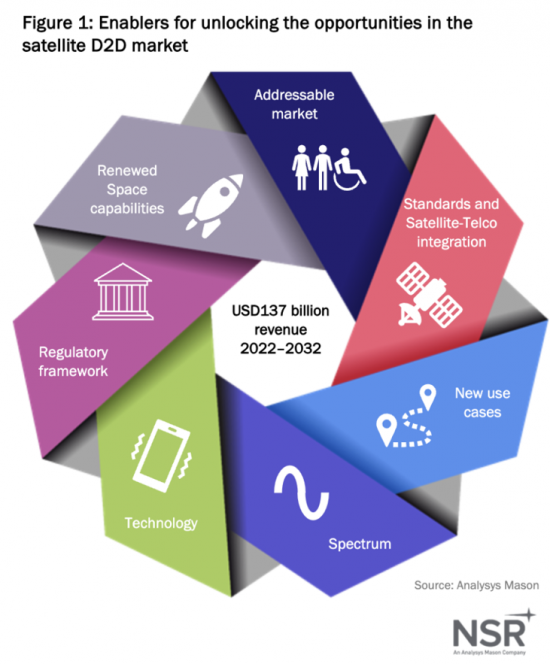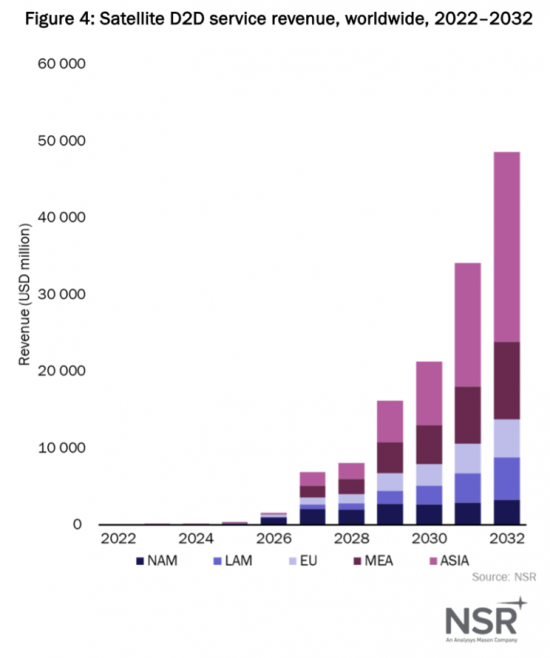 |
市場調查報告書
商品編碼
1348940
衛星 D2D(Direct-to-Device)市場:第四版Satellite Direct-to-Device Market, 4th Edition |
||||||
報告概述
衛星 D2D(Direct-to-Device)市場:第四版全面介紹了衛星 D2D 市場機會、市場驅動因素、限制因素、關鍵用例、戰略見解等。
市場機會與概述:
- 本報告探討了衛星 D2D 市場,這是衛星產業的關鍵成長領域。
- NSR 是最早發現此市場機會的市場研究公司之一,本報告是第四次更新。
優先領域:
- "D2D4" 目的是全面了解衛星 D2D 市場的趨勢和戰略選擇。
- 依地區和細分市場預測服務收入和流量。
- 向衛星營運商、行動網路營運商(MNO)以及設備和基礎設施供應商提供有關如何佔領這一不斷成長的市場的建議。
主要問題:
- 新興衛星 D2D 市場存在哪些收入機會?
- 除地面無線電之外,行動網路業者還可以使用衛星 D2D 瞄準哪些用例?
- 衛星 D2D 的限制與優點是什麼?
- 將塑造市場未來的關鍵技術發展是什麼?
- 主要參與者及其各種策略(頻率、供應和產能、標準、商業模式等)


目標受眾
衛星Direct-to-Device市場本報告針對衛星和通訊行業的各個利益相關者,例如:
- 衛星營運商尋求了解收入潛力、流量預測、市場動態。
- MNO 和 CSP對衛星 D2D 作為成長和差異化來源感興趣。
- 想要評估頻段、標準和業務模式的策略選擇的晶片組和組件供應商、OEM 和基礎設施供應商(太空和地面)。
- 監管機構和行業機構希望利用 D2D 促進創新並彌合數位落差。
差異化因子
- 衛星Direct-to-Device市場是 NSR 在衛星行業的專業知識與 Analysys Mason 對通訊趨勢的了解的獨特結合所帶來的。
- "D2D4" 充分利用了 Analysys Mason 對航太產業的了解以及對營運商趨勢和消費者需求的洞察。
- 第四版基於廣泛的初步研究,包括對主要行業參與者的採訪,以及堅實的二次研究基礎。
- 第四版作為未來策略決策的路線圖,將提供讀者了解動態衛星 D2D 領域的各個細分市場、區域和策略選擇的協助。
衛星Direct-to-Device市場:第四版為有興趣利用新興衛星 D2D 市場機會的產業利害關係人提供寶貴的見解。本報告利用 NSR 和 Analysys Mason 的專業知識,對不斷發展的衛星 D2D 市場提供全面、公正的分析。
主要功能
本報告的目標
- 參與衛星 D2D 生態系的主要建議
- 依地區和細分市場劃分的服務收入預測
- 依地區和細分市場劃分的流量預測
- 目標市場的定義
- 衛星 D2D 功能的主要優點和限制回顧
- 技術演進的時機及其對市場發展的影響
- 關鍵策略選擇的評估與影響:頻率、標準、商業模式
報告細分
- 消費者
- 交通
- 服務收入
- 物聯網
- 交通
- 服務收入
- 政府和軍隊
- 交通
- 服務收入
此報告中包含的公司
Airbus、Apple、AST SpaceMobile、AT&T、Bullitt、Echostar、Ericsson、Globalstar、Honor、Huawei、Inmarsat、Iridium、Lynk、Mediatek、Motorola、Nokia、Nothing、OmniSpace、Oppo、PNCC、Qualcomm、Rakuten、Sateliot、SCT、Skylo、SMART、Starlink、Telefónica、Thales Alenia Space、T-Mobile、vivo、Vodafone、Xiaomi。
目錄
關於此報告
執行摘要
調查概述
- 挑戰:行動網路營運商的收入來源和社會影響受到地面網路覆蓋範圍的限制
- 解決方案:衛星 D2D 透過提高用戶參與度、支援新服務和降低農村網路部署成本,為 MNO 帶來更多機會
建議
- 1.D2D 作為 MNO 差異化和成長的新來源
- 1.到2032年,衛星 D2D 服務收入將飆升至 486億美元
- 2.D2D 吸引了來自三個主要領域的市場興趣:消費者、物聯網和政府/軍事
- 3.消費者領域在收入領域佔據主導地位,但物聯網和政府/軍隊提供了專門的機會
- 4.衛星 D2D 對 MNO 來說不構成競爭風險,因此該技術應被視為實現新收入來源的一種手段。
- 2.適合快速發展的技術和業務
- 1.該產業的利害關係人必須繼續適應技術和業務快速發展。
- 2.供應時機對於平衡市場準備和競爭優勢非常重要。頻譜是一種重要的資源。需要指數級供應量增加
- 3.價值鏈調整
- 1.建構合適的合作夥伴生態系統是提供複雜的D2D 解決方案的關鍵
- 2.由於向後相容性,使用 MNO 頻譜可以實現更快的啟動。監管的確定性和績效的提高為 MSS 創造了長期利益。
- 3.專有協定提供了更快的商業化途徑,但應優先考慮基於標準的解決方案以促進可擴展性。
- 4.衛星服務應著重於對行動網路業者有吸引力的批發模式。
附錄:研究方法
關於作者和 Analysys Mason
Report Summary:
“Satellite Direct to Device Markets, 4th Edition (D2D4) ” report provides a comprehensive analysis of the satellite D2D (Direct-to-Device) market opportunity, including market drivers and restraints, key use cases, and strategic insights.
Market Opportunity and Overview:
- The report describes the satellite D2D market opportunity, which represents a significant growth area within the satellite industry.
- NSR was one of the first market research firms to identify this opportunity, and this report represents the 4th annual update with a high level of maturity and in-depth analysis.
Key Focus Areas:
- “D2D4” aims to build a complete picture of trends and strategic choices within the satellite D2D market.
- It provides forecasts for service revenues and traffic broken down by region and market segment.
- Recommendations are offered for satellite operators, mobile network operators (MNOs), and equipment and infrastructure vendors on how to capture a portion of this growing market.
Key Questions Addressed:
- What is the revenue opportunity for the emerging satellite D2D market?
- What use cases can MNOs target beyond their terrestrial coverage leveraging satellite D2D?
- What are the limitations and strength of satellite D2D?
- Which are the key technology developments that will shape the future of the market and how should players stay adaptive to this evolution?
- Who are the main players and which are the different strategies (spectrum, supply and capabilities, standards, business models, etc.)?


Target Audience
“Satellite Direct to Device Markets” report is intended for various stakeholders in the satellite and telecommunications industries, including:
- Satellite operators seeking to understand revenue potential, traffic forecasts, and market dynamics.
- MNOs and CSPs interested in satellite D2D as a source of growth and differentiation.
- Chipset and parts vendors, OEMs, and infrastructure vendors (both space and terrestrial) looking to assess strategic choices in terms of spectrum, standards, and business models.
- Regulators and industry agencies seeking to leverage D2D to foster innovation and bridge the digital divide.
Differentiating Factors:
- “Satellite Direct to Device Markets” stands out due to the unique combination of expertise from NSR in the satellite industry and Analysys Mason's knowledge of telecommunications trends.
- “D2D4” leverages understanding of the space industry and Analysys Mason's insights into telco trends and consumer needs.
- “Satellite Direct to Device 4” draws from extensive primary research, including interviews with key industry players, and is based on a solid foundation of secondary research.
- “D2D4” serves as a roadmap for future strategic decisions, helping readers navigate various market segments, regions, and strategic options in the dynamic satellite D2D landscape.
“Satellite Direct to Device Markets, 4th Edition” report offers valuable insights and recommendations for industry stakeholders interested in capitalizing on the emerging satellite D2D market opportunity. It leverages the expertise of NSR and Analysys Mason to provide a comprehensive and unbiased analysis of this evolving landscape.
Key Features:
Covered in this Report:
- Key recommendations for participating in the satellite D2D ecosystem
- Service revenues forecast by region and segment
- Traffic forecast by region and segment
- Addressable market definition
- Review of the key strength and limitations of the satellite D2D capabilities
- Timing of the technology evolution and implications for the development of the market
- Assessment and implications of key strategic choices: spectrum, standards and business models
Report Segmentation:
- Consumer
- Traffic
- Service Revenues
- IoT
- Traffic
- Service Revenues
- Government and Military
- Traffic
- Service Revenues
Companies included in this Report:
Airbus, Apple, AST SpaceMobile, AT&T, Bullitt, Echostar, Ericsson, Globalstar, Honor, Huawei, Inmarsat, Iridium, Lynk, Mediatek, Motorola, Nokia, Nothing, OmniSpace, Oppo, PNCC, Qualcomm, Rakuten, Sateliot, SCT, Skylo, SMART, Starlink, Telefónica, Thales Alenia Space, T-Mobile, vivo, Vodafone, Xiaomi.
Table of Contents
About this report
Executive summary
Research overview
- Challenge: MNOs' revenue sources and social impact are limited by the reach of terrestrial networks
- Solution: Satellite D2D extends MNOs' opportunities by boosting subscriber engagement, enabling new services and reducing rural network deployment costs
Recommendations
- 1. D2D as MNOs' new source of differentiation and growth
- 1. Satellite D2D service revenues to skyrocket to 48.6USD billion by 2032
- 2. D2D will attract market interest from 3 main segments: consumer, IoT and Gov/Mil
- 3. Consumer segment to dominate the revenue scene, but IoT and Gov/Mil present specialized opportunities
- 4. Satellite D2D does not represent a competitive risk for MNOs. The technology should be regarded as an enabler for new revenue streams
- 2. Fit for the fast-paced technology and business evolution
- 1. Actors in the field should stay adaptative to the extraordinarily fast evolution in technology and business
- 2. Timing of supply is critical to balance market readiness and competitive advantage. Spectrum is the key resource. Exponential supply growth needed
- 3. Aligning the value chain
- 1. Building the right ecosystem of partners is critical to deliver D2D's complex solution
- 2. Using MNOs' spectrum offers faster ramp-up thanks to backward compatibility. MSS long-term advantages due to regulatory certainty and enhanced performances
- 3. Standards-based solutions should be the preferred approach to facilitate scalability, albeit proprietary protocols offer a faster path to commercialization
- 4. Satellite offerings should focus on wholesale models that are attractive for MNOs
Appendix Methodology
About the authors and Analysys Mason
List of Exhibits
- Figure 1: Evolving Space enablers unlocking the opportunities in the satellite D2D market
- Figure 2: MNOs' limitations to create and capture value beyond their coverage
- Figure 3: Key segments enabled by satellite D2D
- Figure 4: Satellite D2D service revenues worldwide, 2022-2032
- Figure 5: share of service revenues per vertical worldwide
- Figure 6: satellite D2D cumulative service revenues (USD million) worldwide, 2022 to 2032
- Figure 7: Satellite D2D traffic with technology phases worldwide, 2022 to 2032
- Figure 8: generic legacy constellation supply case study













